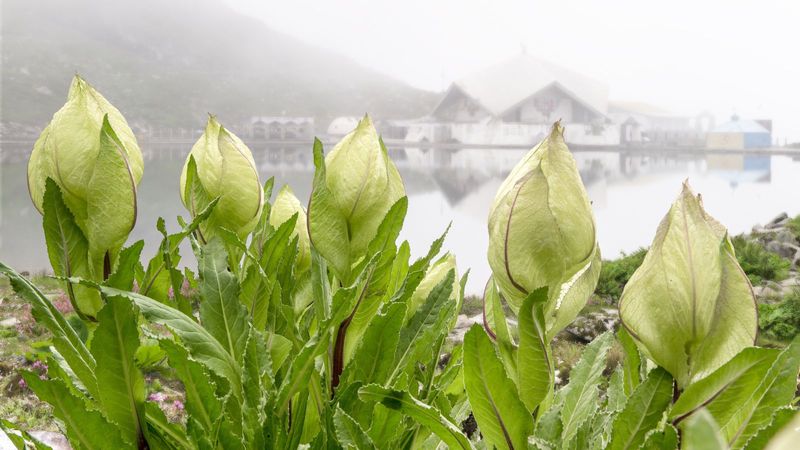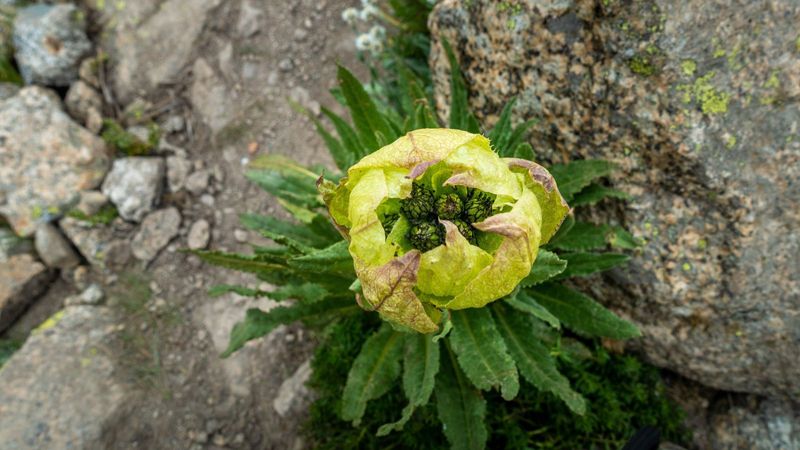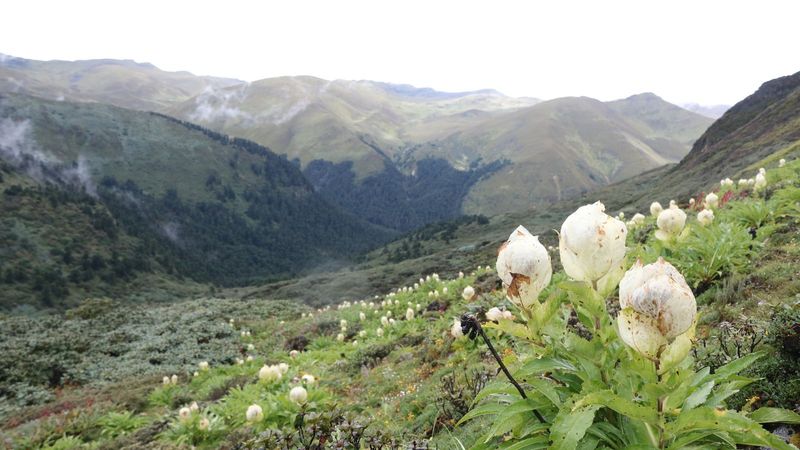The Chamoli region of Uttarakhand is host to breathtaking sites such as Badrinath Temple, Roop Kund ice sheet, and Nanda Devi peak—as well as a plethora of gorgeous Brahma kamal flowers that blanket the area. The holy lotus, or Brahma Kamal, is a unique plant that blooms from August to mid-September in the heights of Uttarakhand and Himachal Pradesh. As per specialists, the flowers have begun to blossom off-season as a consequence of weather changes and a reduction in visitor traffic.
The Brahma Kamal flower is distinguished by the fact that it blooms exclusively after sundown. Brahma Kamalam belongs to the plant family Saussurea Obvallata, and it bears purple flower heads surrounded by layers of boat-shaped, greenish-yellow petals. It usually blooms only once a year, from August to mid-September at altitudes between 3,500 to 3,800 meters. The pink Brahma kamal, commonly known as the king of Himalayan flowers, is the state flower of Uttarakhand. The flower's healing properties are well-known in Tibetan therapy and Ayurveda. It is widely used in the local community to heal wounds and bruises.
What is Brahma Kamal?

While worshipping deities, holy sanctuaries such as Kedarnath and Badrinath use only real Brahma Kamal. Simply put, Brahma Kamalam means 'Lotus of Brahma.' The cosmos is said to have been created by Lord Brahma, and this flower is associated with him.
The national flower of Uttarakhand has an eight-inch diameter and blooms in approximately two hours. The flower also has a variety of therapeutic benefits. Locals use it to cure wounds and bruises. It can also be used to treat bone problems, liver infections, colds and coughs, and other diseases. In Tibetan medicine, the Brahma Kamal tree is known as Sah-du Goh-ghoo. It has a somewhat bitter flavour and encourages heat. Brahma kamal plant importance can be best explained by the fact that is also used to treat cerebral ischemia and limb paralysis. In fact, the entire plant is utilized for a variety of applications.
When does Brahma Kamal bloom?
The Brahma kamal blooming time is only once a year. It takes two hours for it to completely bloom to a circumference of eight inches. From August until mid-September, the blooms are usually observed taking on their beautiful form. However, due to climate change, the blooms blossomed in October in the higher parts of Uttarakhand's Rudraprayag district. It was also found flowering in Uttarakhand's Chamoli district. The flower usually blooms for a few hours, and those who see it are said to be blessed with good fortune and wealth. A lonesome flower, this kamal blooms for a few hours before reverting to its original state and dying in the morning. The flower blooms after sunset, about 7 PM and measures about 8 inches in diameter, remaining open throughout the night.
The best time to see Brahma Kamal Flower

It is only cultivated in Uttarakhand between the months of April-May and October. Flowers bloom in mid-monsoon among the rocks and grasses of the hillside at elevations ranging from 3,000 to 4,800 meters. Purple flower heads are veiled from view by layers of yellowish-green papery bracts that give shelter from the chilly alpine environment. Because of climate change, Brahma Kamal flowers, which used to bloom from August to mid-September, are now flowering in Garhwal of Chamoli district, Uttarakhand in October. The months of July-September (during Sarad Purnima) are ideal for Brahma kamal blooming since the weather is warm enough for flower buds to grow and unfold. Its leaves give rise to the blooms.
Brahma Kamal flower pooja
Brahma Kamal plants are very important in Hindu mythology. The flower is thought to be named after Lord Brahma. Anyone who observes this flower blooming in the middle of the night considers all of his aspirations to be fulfilled and have the Brahma kamal plant blessings. People believe that due to Brahma Kamal's spiritual significance, it should always be given as a gift and should never be sold or purchased. Brahma Kamal has mysterious and divine power in Hindu mythology, and the blooms are presented to Lord Vishnu. Brahma Kamal may be found in the Uttarakhand districts of Kedarnath, the Valley of Flowers, Hemkund Sahib, and Tungnath. In the region, the plant has enormous religious importance. It is considered a spiritual flower and is presented to Lord Vishnu at the Badrinath temple and Lord Shiva at the Kedarnath shrine.
Brahma Kamal trek

We believe that trekking should be avoided during the rainy season, especially in the Himalayas. The reality, on the other hand, is quite the contrary. The monsoon season is one of the greatest periods to hike in the Himalayas. The Valley of Flowers journey spans six days and covers 38 kilometres. It is surrounded by two protected areas: Valley of Flowers National Park and Nanda Devi Biosphere Reserve. This location is also known for its Himalayan splendour since it is the meeting point of the Zanskar, Eastern, and Western Himalayas. Although it is open from June to September, the months of July and August are the finest for this hike. Being adequately prepared is the best way to enjoy this walk. Trekking in the rain may be incredibly pleasurable if well prepared. In the month of June, Brahma Kamal flowers can be found near the streams of the Valley of Flowers specifically the Pushpawati River bed.
Disclaimer: The details mentioned throughout this blog are sourced from publicly accessible platforms. At Zeezest, we intend to share factual and verified information. Should there be any inconsistencies or variances in the information provided, please understand that these are entirely unintentional and not meant to mislead.



